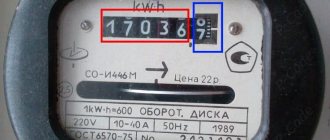The cost of electricity is constantly rising, and every time bills from energy sales companies arrive, despondency sets in. Consumers often wonder how they can legally save on electricity without paying huge sums of money. One solution to this issue is the installation of a two-tariff meter. But is this method of saving suitable for the average consumer? Is a two-tariff meter still beneficial or not?
Classification of electricity meters
Electricity metering devices differ in the number of tariff zones. Their difference is that they are divided into single-tariff and multi-tariff.
A single-tariff meter records the consumption of electrical energy around the clock at one tariff.
In turn, multi-tariff electricity meters are divided into subtypes:
- accounting for two zones (two tariffs): day (peak) zone T1 and night T2;
- accounting for three zones (three tariffs): peak zone T1, half-peak zone T2 and night T3;
- metering in four zones (four tariffs): designed for metering electricity of large enterprises.
A multi-tariff meter records the volume of electricity at a certain time of day (zones). In Russia, no more than three tariffs are accounted for.
Varieties
There are single-phase, three-phase, first and second class meters. There is a classification of units with additional options: the ability to save readings for past calendar months, with the ability to transfer readings directly to the supplier and with a log of peak periods. Devices are also divided according to installation method. There are rack, three-point and combined mounts.
A type of two-tariff counting equipment
The principle of operation of a two-tariff meter
It is not difficult to understand how a two-tariff electricity meter works and what is the difference between a single-tariff and multi-tariff electricity meter. It records energy consumption in two periods: during the day from 7.00 to 23.00 and at night - from 23.00 to 7.00. This differentiated metering by zone is what distinguishes a two-tariff meter from a conventional single-tariff meter, which records data around the clock at one tariff.
Electrical energy consumed in private or apartment buildings during the day varies greatly, which can be clearly seen on the load graph of an apartment building.
An example of a daily load schedule for an apartment building.
The graph shows that at night, from approximately 1.30 to 6.00, the amount of electricity consumed is the lowest. And the peak load occurs in the evening from 18.00 to 22.00.
Such a schedule can be a strong motivation to use electrical appliances at night. Household appliances with high energy consumption (washing machine, dishwasher, electric kettle, microwave oven, iron, air conditioner) are preferably used during lower peak loads, and their use at night will allow you to save a lot of money.
How do you know if it is profitable for you to take a meter with two tariffs?
To combine a comfortable life and low electricity bills, you don’t need to adjust to the meter. All you have to do is choose a device that suits your needs. To understand whether installing a two-tariff electric meter is beneficial for you, you need to complete three steps:
- Calculate at what ratio of night and day electricity consumption (when calculating according to two tariff plans) the payment will be equal to what is considered one rate (at one tariff);
- Calculate the average actual electricity consumption at night and during the day;
- Compare the actual ratio of nighttime to daytime consumption with what was calculated in point 1.
If the actual night-to-day ratio is less than the calculated one, then having an electric meter with two tariff plans is unprofitable. If they are equal, then it makes no difference what kind of counting device you have. You will notice the benefit only when the actual ratio of night to day is greater than the calculated ratio.
Definition of design ratio
To do this, you need to know how much 1 kWh of electricity costs:
- For single-rate payment (OO);
- At night (BUT);
- During the day (BEFORE).
Calculation procedure:
- Find the difference between OO and NO;
- Find the difference between DO and OO;
- Divide the result of action 1 by the result of action 2;
- Add 3 units to the result;
- Divide one by the result of action 4;
- Multiply the number obtained after step 5 by 100. This will be the calculated ratio (RO) of night-time energy consumption to daytime, at which the payment for electricity at least does not increase when installing a two-tariff meter.
This can be expressed in one formula, but it is complex:
Example. OO - 3.6 rubles per 1 kW*hour, NO - 1.8, and DO - 3.9 rubles. We find the difference between OO and HO - this is 1.8. Then we find the difference between DO and OO - this is 0.3. Now divide 1.8 by 0.3. We get 6. Add 1 - now we have 7. Divide 1 by 7 and get approximately 0.14. And multiplying by 100%, we get 14%. This means that your nighttime energy consumption must be at least 14% of the total (day + night), so that installing a meter with two tariffs does not hit your pocket.
Definition of actual ratio
Now you need to find out how much electricity you actually spend at night and during the day. To do this, take readings twice every day for one month at exactly 7.00 and 23.00. Then, by subtracting the penultimate reading from the last, calculate how much you spend on average during the day and how much at night. It is convenient to record data in a table, as in the figure below.
Average daily flow rate (ADF) is the sum of all daily readings divided by the number of days in a month. The average night consumption value (ANV) is the sum of all night readings, also divided by the number of days in a month.
The actual ratio (FR) is found using the formula:
Example from the table: SZDR = 7, and SZNR = 3. Then FO = 3/(3+7)*100% = 30%.
Comparison of calculated ratio with actual ratio
How do you know that single-phase, two-tariff electric meters will bring benefits? We need to compare the relationships we obtained: RO with FO. Three cases are possible:
- RO>FO. Your costs will increase when installing an electric meter with two tariffs. You don't need this;
- RO=FO. Costs will remain the same. There is no point in reinstalling;
- RO<FO. The transition to two-tariff payment will bring economic benefits.
Example. Our RO is 14%, and FO is 30%. This is the third case, which says that a two-tariff electric meter will help us save money when paying for electricity.
Calculation of the economic effect of switching to a two-tariff meter
Before making a decision to replace a single-tariff meter, it is advisable to calculate the efficiency of switching to a two-tariff electric meter.
Regional authorities independently determine tariffs for the supply of eclectic energy, so the cost per kilowatt-hour in each subject of the Russian Federation is different. Tariffs usually change every six months. And their changes, unfortunately, are only increasing.
As an example for calculation, you can take tariffs for the first half of 2021 in the Lipetsk region.
Single-rate tariff - 3.67 rubles. per kW/h.
Two-zone tariff:
- day - 4.22 rub. per kW/h;
- night — 2.20 rub. per kW/h.
The difference between the consumption of electrical energy during the day and at night is almost 2 times different and amounts to 2.02 rubles. per kW/h.
During the same period in the Irkutsk region, prices differ:
Single-rate tariff - 1.11 rubles. per kW/h.
Two-zone tariff:
- day - 1.27 rub. per kW/h;
- night — 0.74 rub. per kW/h.
The difference in the Irkutsk region was only 0.53 rubles. per kW/h.
Using the examples of two regions, we can conclude: in the Lipetsk region, the transition to a two-tariff meter will become feasible, but in the Irkutsk region it is practically unprofitable.
Therefore, before installing a new meter, it is worth analyzing the cost of electricity in your region, assessing the economic effect and considering whether it is profitable or not.
Connection diagram
As a rule, the connection diagram is indicated on the device itself or in the instructions for it. Below is the simplest diagram according to which you can quickly, independently and without unnecessary problems connect any unit.
The simplest connection diagram
In general, a two-tariff electric meter is a device that operates in an economical mode by reducing the consumption of energy resources and protecting the home electrical network from tripping of protective equipment. It has its pros and cons. It is profitable to install it, according to user reviews.
You might be interested in why they install RCDs
Selecting a meter, its cost and installation
You can purchase an electrical energy meter at any electrical goods store. Sales consultants will tell you what a two-tariff meter is, which ones are good, and give advice on choosing an electronic device. The cost of equipment depends on the manufacturer, model, accuracy class and service life.
A brief overview of budget electronic (static) electricity meters.
| № | Name | Manufacturer country | Accuracy class | Warranty period, years | Service life, years | Average price, rub.* |
| 1 | TAIPIT NEVA MT 124 AS OR 1ph 5-60A 220V | Russia | 1 | 7 | 30 | 2660.00 |
| 2 | INCOTEX MERCURY 206 RN 1ph 5-60A 1.0/2.0 | Russia | 2 | 3 | 30 | 2400.00 |
| 3 | ENERGOMERA 459547 CE 102 R5.1 145 J 1ph 5-60A | Russia | 1 | 4 | 30 | 1550.00 |
| 4 | SOE-55/50Sh-T-112 MZEP | Russia | 1 | 3.5 | 32 | 1450.00 |
*According to the website https://lipetsk.220-volt.ru.
- TAIPIT NEVA MT 124 AS OR 1ph 5-60A 220V.
- INCOTEX MERCURY 206 RN 1ph 5-60A 1.0/2.0.
- ENERGOMERA 459547 CE 102 R5.1 145 J 1ph 5-60A
- SOE-55/50Sh-T-112 MZEP.
More expensive two-tariff meters with advanced functionality are also sold, but not always expensive ones with many functions that are much better than usual. Still, the main task of the device is to correctly record data.
Before purchasing, you should pay attention to the accuracy class, verification time and the availability of additional maintenance for a multi-tariff meter.
Popular models
Today, three models of two-tariff meters are most in demand on the market - MZIP, Energomera and Mercury. Let's take a closer look at them.
Mercury
Mercury meters are produced by , which produces a wide range of metering devices - from conventional 1-phase devices to more complex 3-phase models.
The products are manufactured at a high technical and scientific level, which makes NPK Incotex one of the best companies today.
Now the company produces other products - cash registers, automated accounting and control systems, various types of screens and displays, POS and other equipment.
Popular multi-tariff meters include the following Mercury models:
- Three-phase - 256 ART, 234 ARM (2), 230 ART, 231 AT, 231 ART Sh.
- Single-phase - 206, 203.2T, 201.8 TLO, 200.
Energy meter
The Energomera company positions itself as the Russian market leader in the production of metering devices. Every year, more than 3 million metering devices are produced at the enterprise's factories. Moreover, over 20 years of operation, more than 30 million devices have been produced.
The company includes 4 factories and 1 institute. In addition to two-tariff meters, the company produces ASKUE systems, low-voltage equipment, metrological and switchboard equipment, devices for electrochemical protection and other equipment.
Popular models of multi-tariff meters include:
- Single-phase - CE 102-R5.1, CE 102M-R5, CE 102-S7, CE 102M-S7, CE 201-S7.
- Three-phase - CE 307-R33, CE 301-R33, CE 307-S31, CE 303-R33, CE 303-S31.
MZEP
At the moment, the Moscow MZEP plant is considered one of the best in the field of manufacturing metering devices. Every month, the plant produces more than 100,000 devices, which are used both in private homes and in large organizations.
The company's products are certified and meet internationally accepted quality standards. Before sale, the plant's two-tariff meters are tested by the metrological service, and their compliance with the requirements is confirmed by certificates.
Popular multi-tariff models of the manufacturer:
- Single-phase - AGAT 2-12, AGAT 2-23M, AGAT 2-23M1, AGAT 2-27M, AGAT 2-42.
- Three-phase - AGAT 3-1.100.2, AGAT 3-1.5.2, AGAT 3-1.50.2, AGAT 3-3.100.5, AGAT 3-3.60.2.
Calculation of consumed electrical energy
On average, electricity consumption in a 3-room apartment with an area of 60 sq.m per month is approximately 250–300 kW. In winter, consumption increases due to short and cold days, and in summer, on the contrary, it decreases.
Before choosing a single-tariff or two-tariff electric meter, you need to analyze the amount of electricity consumed by time of day, your daily routine, what time your working day starts and ends. If the main peak and consumer activity occurs at night, then it is better to install a two-tariff meter. With a more detailed analysis of electricity use, you can install a three-tariff electricity meter, if this is most appropriate.
The cost of installation work varies in each region. The price for the service ranges from 500 to 1500 rubles. Installing a two-tariff electricity meter is a short process, but requires high professionalism of an electrician.
Payment for work on weekends and non-working holidays
According to Art. 153 of the Labor Code of the Russian Federation, work on a day off or a non-working holiday is paid at least double the amount:
- for piece workers - at no less than double piece rates;
- employees whose work is paid at daily and hourly tariff rates - in the amount of at least double the daily or hourly tariff rate;
- for employees receiving a salary (official salary) - in the amount of at least a single daily or hourly rate (part of the salary (official salary) for a day or hour of work) in excess of the salary (official salary), if work on a day off or a non-working holiday was carried out within monthly standard working time, and in an amount of at least double the daily or hourly rate (part of the salary (official salary) for a day or hour of work) in excess of the salary (official salary), if the work was performed in excess of the monthly standard working time.
In this case, specific amounts of payment for work on a day off or a non-working holiday can be established by a collective agreement, a local regulatory act adopted taking into account the opinion of the representative body of employees, or an employment contract.
Let us remind you that according to the Labor Code of the Russian Federation, wages (employee remuneration) consist of:
- from remuneration for labor depending on the qualifications of the employee, complexity, quantity, quality and conditions of the work performed by him;
- from compensation payments (additional payments and bonuses of a compensatory nature, including for work in conditions deviating from normal, special climatic conditions and in territories exposed to radioactive contamination, and other payments of a compensatory nature);
- from incentive payments (additional payments and incentive allowances, bonuses and other incentive payments).
Rostrud employees base their new clarifications on payment for work on a day off or a non-working holiday on Resolution of the Constitutional Court of the Russian Federation No. 26-P.
In paragraph 3.5 of the said resolution it is noted: Art. 153 of the Labor Code of the Russian Federation, considered in the system of current legal regulation, does not in itself imply that work on a day off or a non-working holiday performed by employees whose remuneration system, along with the tariff part, includes compensation and incentive payments, will be paid based on only one component wages - salary (official salary), and these employees, when calculating the amount of payment for work performed by them on a weekend or holiday, may be arbitrarily deprived of the right to receive appropriate additional payments, which leads to an unacceptable reduction in the remuneration due to them for work compared to payment of similar work performed on a normal working day.
Thus, when paying for work on a day off, the employer must take into account not only the tariff part of the salary, regional coefficients and percentage bonuses, but also compensation and incentive payments, as well as bonuses. This interpretation of Art. 153 of the Labor Code of the Russian Federation is given in the Resolution of the Constitutional Court of the Russian Federation No. 26-P.
In addition, Rostrud noted: despite the fact that the court ruling deals with civilian personnel of military units, it also states that the interpretation of Art. 153 of the Labor Code of the Russian Federation is generally binding; this conclusion of the Constitutional Court of the Russian Federation applies to all employers without exception.
Calculation of economic benefits
To calculate savings, you need to compare costs for two types of metering devices.
Example.
Consumption in winter is 300 kW per month. Tariff - 3.67 per kW/h. Thus, with a single-tariff meter installed, the consumer will have to pay for the services: 300×3.67 = 1101.00 rubles.
Consumption in winter is 300 kW per month, but 100 kW is during the day and 200 kW at night. The volume of kilowatts is calculated separately, each according to its own tariff. Day – 100×4.22=422.00 rub., night – 200×2.20=440.00 rub. The total amount for the two-tariff meter for the month will be 862.00 rubles.
Now the difference is calculated and the savings are determined: 1101.00−862.00=239.00 rub.
Over the course of a year, a larger amount comes out: 239.00×12=2868.00 rubles.
Using economic calculations as an example, it is obvious that installing a two-tariff meter allows you to save a lot of money.
Calculation ratio: by what rules is it calculated?
First you need to find out the cost of one kilowatt of electricity per hour. And the numbers need to be determined under different conditions:
- When using a single-bet scheme.
- Daytime.
- Night time.
The calculation procedure has its own sequence:
- The difference between single rate pay and night time is determined.
- Next we need the difference between daytime and single rate type.
- The result of the first action is divided by the numbers of the second.
- We add one to the result of the third stage.
- We divide one by the result of 4 actions.
- Multiplying the number obtained from the previous operation by a hundred.
What about the actual relationship?
This indicator will help you find out how much is actually spent on energy both at night and during the day. To do this, you need to take readings every day for one month. This is done twice, at 7 am and 11 pm. After this, the penultimate result is subtracted from the last one. This way you can determine the average consumption for the night and day. It is better to record the data in the form of a table, then it will be more convenient.
The average daily flow rate can also be easily calculated by dividing the sum of all daily readings by the number of days in the month. The same goes for calculating the average level at night.
The actual ratio also has its own formula.
- We take the average nightly result.
- We divide it by the sum of the daytime and nighttime averages.
- We multiply the figure from the previous result by one hundred percent.
Read more: Briefing on fire safety in the workplace
Payback period for purchasing a new device
If you buy the cheapest device, for example, for 1450.00 rubles, then it will pay for itself in 6–7 months: 1450.00/239.00=6.07. When purchasing a more expensive device, for example, for 2660.00 rubles. — the payback period will be approximately one year: 2660.00/239.00=11.1.
If we include the cost of services for installing the device (on average 700 rubles), then the payback in the case of purchasing two meters of different prices will be:
- Let's calculate in the first case: (1450.00+700.00)/239.00=9;
- and in the second case: (2660.00+700.00)/239.00=14.
Even if you pay for the services of an installation specialist, the payback is quick and will be 9 and 14 months.
All calculations were carried out approximately, so each consumer must make an independent calculation based on his readings and the tariffs of energy sales companies.
Calculation of savings in houses with installed electric stoves
Residents of high-rise buildings do not have gas supply, since the pressure in gas pipes can only reach 10 floors. According to the plan, apartments in such houses are equipped exclusively with electric stoves.
In houses equipped with stationary electric stoves and electric heating installations, the electricity tariff is significantly lower.
Before leaving a single-tariff meter or installing a two-tariff meter, you need to understand whether this is beneficial in terms of electrifying the entire house, take this fact into account and carry out the calculation.
As an example for the calculation, we took the cost of the tariff rate for residents living in houses with installed stationary electric stoves and electric heating installations for the first half of 2021 in the Lipetsk region.
Single-rate tariff - 2.57 rubles. per kW/h.
Two-zone tariff:
- day - 2.96 rub. per kW/h;
- night — 1.54 rub. per kW/h.
Estimated consumption in winter is 300 kW per month. Single-rate tariff - 2.57 per kW/h. Thus, with a single-tariff meter, the consumer will pay for the services of energy sales companies: 300 × 2.57 = 771.00 rubles.
Consumption in winter is also 300 kW per month, but 100 kW is during the day and 200 kW at night. The volume of kilowatts is calculated at a tariff differentiated between two zones. Day – 100×2.96=296.00 rub., night – 200×1.54=308.00 rub. The total amount for a two-tariff meter per month will be 604.00 rubles.
Calculation of the difference and determination of savings: 771.00−604.00=167.00 rub. per month, and per year - 167.00 × 12 = 2004.00 rubles.
The savings are slightly lower than in houses with gasification, but over time, for example, over a year it still turns out to be quite a significant amount. In houses with built-in electric stoves, the consumer himself chooses the optimal metering tariff for him and whether the electric meter needs to be replaced.
LED bulbs
LED lighting
These are, as a rule, expensive lighting elements and are not available in every store, but if you replace all the light points in the house with them, you can get significant savings.
The number of light bulbs is an individual preference of the home owners and depends on the available area of the room. As a rule, in a two-room apartment there are only five stationary points, but sophisticated renovations sometimes require 25 elements. To make the calculation, for example, let’s take the average value equal to 15 light bulbs in the house.
Instructions for switching to a two-tariff meter
When the decision to switch has been made, you can replace the old electric meter with a new device.
To do this, the following algorithm of actions is observed:
- Submit an application to the regional energy sales company for installation of a two-tariff meter in person, or through your personal account on the official website.
- Purchase a suitable multi-tariff meter.
- Pay for services to replace the electric meter.
- Within 10 working days, an employee of the energy sales company will come and take readings from the old meter, dismantle it, install a new one, put it into operation and seal it.
- Sign a certificate of completion of work on commissioning, a service agreement.
You can buy an electric meter directly from the energy sales company itself, which often provide this opportunity and offer two-tariff meters. It is prohibited to independently dismantle an old metering device or break seals and is punishable by a fine.
Features when deciding to switch to a two-tariff electricity meter
Before installing a new meter, there are a number of factors to consider:
- tariffs for the supply of electrical energy and differentiation by zone in the regions of Russia vary;
- there is no guarantee that the cost difference between the “day” and “night” time zones will not change downwards;
- the electric meter must be installed by a specialist;
- consider payback;
- apply an individual approach;
- take into account the absence of gasification when making calculations.
It is impossible to answer the question which meter is better, single-tariff, two-tariff or three-tariff. Their differences lie in the accounting of electrical energy by time of day. Each case is considered individually, since the lifestyle and daily routine, the number of residents, the presence of household appliances with high energy consumption and other factors are taken into account. Each consumer can independently carry out a simple calculation, determine what is more profitable, decide to switch to multi-tariff electricity meters and install it.
Accuracy
In modern electronic models, the accuracy class starts from 2 units, and can also be more than 0.5.
This characteristic is indicated by a number on the device. Information in the technical documentation of the device is also indicated.
It is important to know: the legislative act sets the minimum accuracy class limit for private consumers at a level not lower than “2”.
With standard electricity consumption in an apartment or private house, purchasing an ultra-precise measuring device will simply be irrelevant. The increased cost of the device simply will not pay off over the period of operation. For enterprises with a large amount of powerful equipment, this solution is recommended.











